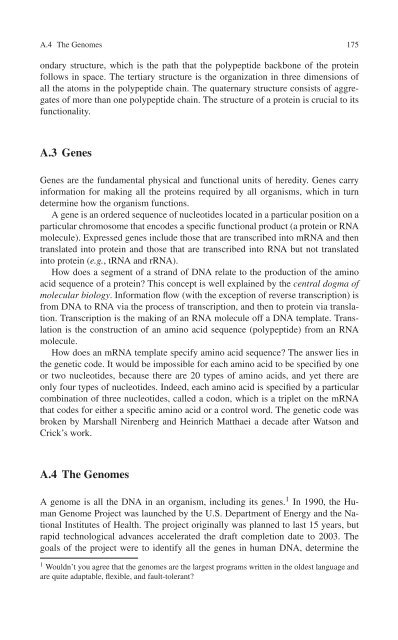You also want an ePaper? Increase the reach of your titles
YUMPU automatically turns print PDFs into web optimized ePapers that Google loves.
A.4 The Genomes 175<br />
ondary structure, which is the path that the polypeptide backbone of the protein<br />
follows in space. The tertiary structure is the organization in three dimensions of<br />
all the atoms in the polypeptide chain. The quaternary structure consists of aggregates<br />
of more than one polypeptide chain. The structure of a protein is crucial to its<br />
functionality.<br />
A.3 Genes<br />
Genes are the fundamental physical and functional units of heredity. Genes carry<br />
information for making all the proteins required by all organisms, which in turn<br />
determine how the organism functions.<br />
A gene is an ordered sequence of nucleotides located in a particular position on a<br />
particular chromosome that encodes a specific functional product (a protein or RNA<br />
molecule). Expressed genes include those that are transcribed into mRNA and then<br />
translated into protein and those that are transcribed into RNA but not translated<br />
into protein (e.g., tRNA and rRNA).<br />
How does a segment of a strand of DNA relate to the production of the amino<br />
acid sequence of a protein? This concept is well explained by the central dogma of<br />
molecular biology. Information flow (with the exception of reverse transcription) is<br />
from DNA to RNA via the process of transcription, and then to protein via translation.<br />
Transcription is the making of an RNA molecule off a DNA template. Translation<br />
is the construction of an amino acid sequence (polypeptide) from an RNA<br />
molecule.<br />
How does an mRNA template specify amino acid sequence? The answer lies in<br />
the genetic code. It would be impossible for each amino acid to be specified by one<br />
or two nucleotides, because there are 20 types of amino acids, and yet there are<br />
only four types of nucleotides. Indeed, each amino acid is specified by a particular<br />
combination of three nucleotides, called a codon, which is a triplet on the mRNA<br />
that codes for either a specific amino acid or a control word. The genetic code was<br />
broken by Marshall Nirenberg and Heinrich Matthaei a decade after Watson and<br />
Crick’s work.<br />
A.4 The Genomes<br />
A genome is all the DNA in an organism, including its genes. 1 In 1990, the Human<br />
Genome Project was launched by the U.S. Department of Energy and the National<br />
Institutes of Health. The project originally was planned to last 15 years, but<br />
rapid technological advances accelerated the draft completion date to 2003. The<br />
goals of the project were to identify all the genes in human DNA, determine the<br />
1 Wouldn’t you agree that the genomes are the largest programs written in the oldest language and<br />
are quite adaptable, flexible, and fault-tolerant?

















